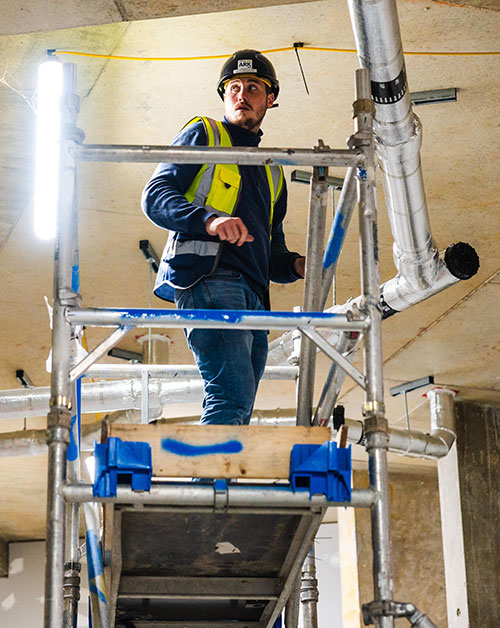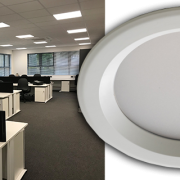
Educational establishments are complex, with many different activities taking place under one roof. Here, Phil Brown, Product and Marketing Director at NVC Lighting, discusses the role that LED lighting can play in helping educational establishments significantly reduce energy costs and their carbon footprint, whilst also creating the optimal learning environment for pupils and staff.
The education sector is a dynamic and demanding environment, where the choice of lighting is more than just a practical consideration, it’s pivotal. It’s not just about creating the right learning conditions to help improve student performance, safety, and well-being, but it’s also about how lighting can help schools and colleges tackle rising energy costs and enhance their sustainability credentials.
In recent years, commercial LED lighting solutions have emerged as the innovative choice for the sector, both in new build and refurbishment projects. Those responsible for the specification process for new educational establishments, or facilities managers in charge of the buildings ongoing maintenance programme, have embraced LED lighting at a rapid rate.
The evolution in LED lighting technology ultimately reflects a strategic response to the evolving needs and priorities of modern schools, colleges, and universities.
One of the key drivers for this is the energy efficiency of LED lights. They consume significantly less electricity compared to traditional incandescent or fluorescent fittings, which translates into substantial cost savings for educational buildings. This can be into the tens of thousands of pounds per year dependent on the size of the building, so payback on investment might be a lot quicker than you think.
The long lifespan of LED solutions further reduces ongoing maintenance and replacement costs as well. These huge energy savings have a massive impact on a building’s carbon footprint, significantly enhancing sustainability and environmental credentials.
Next are the benefits to the overall learning environment. There are so many room types in an educational setting, from the classrooms and sports hall to the kitchens, science labs, reception area, exit doors and workshops, each of which will have its own lighting needs and requirements.
 What’s critical is installing lighting that will improve academic performance, encourage concentration and engagement, and enhance the occupant’s mood and behaviour. LED lighting offers superior quality and control, mimicking natural light more effectively than conventional options.
What’s critical is installing lighting that will improve academic performance, encourage concentration and engagement, and enhance the occupant’s mood and behaviour. LED lighting offers superior quality and control, mimicking natural light more effectively than conventional options.
In classrooms for example, for compliance with BS EN 12464, illuminance at desk level should be 300-500 lux for most classrooms, with 0.6-0.7 uniformity. Glare also needs to be considered carefully, which can prevent students from seeing their teacher, or the whiteboard, clearly. Glare also prevents teachers from making eye-contact with pupils and in the worst case can cause headaches, tiredness, and absenteeism.
Reducing the contrast between ceiling and the light fittings is one way to reduce glare, with the unified glare rating (UGR) recommended to be <19.
The continuous advancement of LED technology means that fixtures can be integrated with lighting controls (smart wireless controls or wired DALI controls), allowing for the central management of lighting systems across multiple buildings. This not only enhances energy efficiency, but it also enables facilities managers to tailor lighting scenarios to specific activities, intermittent occupancy levels, times of the day or seasons in the year.
Motion sensors and daylight harvesting features further optimise energy usage by automatically adjusting lighting levels based on occupancy and natural light availability. If plenty of daylight is available, lighting controls can exploit this, but window rows in classrooms for instance need to be controlled separately from other rows.
For less supervised spaces, like corridors and changing rooms, the lighting solution must be robust, with fittings that feature a high IP rating (impact protection). Changing rooms should have IP44 minimum, whilst kitchens and labs should have IP54 minimum.
There are also custom options available too like circadian lighting, which adjusts colour temperature throughout the day to optimise the learning environment for maximum productivity.
The significance of lighting though extends beyond academic achievement to encompass student and staff well-being and safety too, like preventing accidents or reducing dark spots (either inside or outdoors) that might present opportunities for bullying or anti-social behaviour. The right lighting is also crucial for safety in car parks and on the paths.
Finally, LED lighting can and should be integrated with emergency lighting systems, ensuring educational buildings are fully prepared if a crisis occurs.
With such large and complex spaces with many different areas, some of which being restricted, special consideration needs to be given to how emergency fittings are tested. There are manual and self-test options available, but these can be disruptive, therefore, the most practical is an addressable self-test. This enables users to schedule testing in advance, so it takes place at a suitable time.
At NVC Lighting, we offer a complete end-to-end service for educational establishments, including site surveys and assessments, technical support, and design services. Our commercial LED lighting products are high quality and UGR (glare) compliant, coupled with a seven-year warranty as standard.
What’s more, all our products are really easy to install and maintain and integrated with leading smart lighting control technology, systems can be managed effectively to maximise energy savings and positively impact student and staff performance, safety and well-being.
CLICK HERE
For more information on NVC Lighting’s extensive range of solutions
for educational facilities and its service offering


